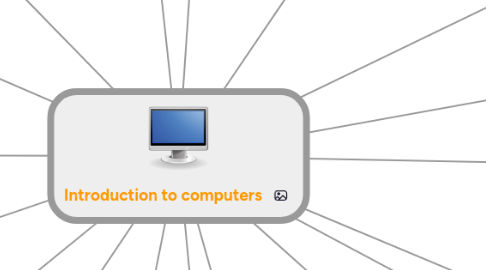
1. Computer Software
1.1. Software
1.1.1. called a program ; tells the computer what tasks to perform and how to perform them
1.2. Installing
1.2.1. is the process of setting up software to work with the computer, printer, and other hardware
1.3. A programmer develops software or writes the instructions that direct the computer to process data into information
2. Categories of Computers
2.1. Personal computers
2.1.1. Mobile computers and mobile devices
2.1.1.1. Game consoles
2.1.1.1.1. Servers
3. Personal Computers
3.1. A personal computer can perform all of its input, processing, output, and storage activities by itself
3.2. Two popular architectures are the PC and the Apple
3.2.1. Desktop computer
4. Mobile Computers and Mobile Devices
4.1. Mobile Computers
4.1.1. Personal computer you can carry from place to place
4.1.1.1. Examples include notebook computers, laptop computers, and Tablet PCs
4.2. Mobile Devices
4.2.1. Computing device small enough to hold in your hand
4.2.1.1. Examples include smart phones, PDAs, handheld computers, portable media players, and digital cameras
5. Game Consoles
5.1. A game console is a mobile computing device designed for single‐player or multiplayer video games
6. Servers
6.1. A server controls access to the hardware, software, and other resources on a network
6.1.1. Provides a centralized storage area for programs, data, and information
7. Mainframes
7.1. A mainframe is a large, expensive, powerful computer that can handle hundreds or thousands of connected users simultaneously
8. Embedded Computers
8.1. An embedded computer is a special‐purpose computer that functions as a component in a larger product
8.1.1. Consumer Electronics
8.1.2. Home Automation Devices
8.1.3. Automobiles
8.1.4. Process Controllers and Robotics
8.1.5. Computer Devices and Office Machines
9. A computer is an electronic device, operating under the control of instructions stored in its own memory
10. The Components of a Computer
10.1. Input Device
10.1.1. Allows you to enter data and instructions into a computer
10.2. Output Device
10.2.1. Hardware component that conveys information to one or more people
10.3. System Unit
10.3.1. Case that contains the electronic components of the computer that are used to process data
10.4. Storage Device
10.4.1. Holds data, instructions, and information for future use
10.5. Communications Device
10.5.1. Enables a computer to send and receive data, instructions, and information to and from one or more computers or mobile devices
11. Advantages of Using Computers
11.1. Speed
11.2. Reliability
11.3. Consistency
11.4. Storage
11.5. Communications
12. Disadvantages of Using Computers
12.1. Health Risks
12.2. Violation of Privacy
12.3. Public Safety
12.4. Impact on Labor Force
12.5. Impact on Environment
13. Networks and the Internet
13.1. Networks
13.1.1. A network is a collection of computers and devices connected together, often wirelessly, via communications devices and transmission media
13.2. Internet
13.2.1. The Internet is a worldwide collection of networks that connects millions of businesses, government agencies, educational institutions, and individuals
13.3. social networking Web site
13.3.1. A social networking Web site encourages members to share their interests, ideas, stories, photos, music, and videos with other registered users
14. Supercomputers
14.1. A supercomputer is the fastest, most powerful computer
14.1.1. Fastest supercomputers are capable of processing more than one quadrillion instructions in a single second
15. Elements of an Information System
15.1. Hardware
15.2. Software
15.3. Data
15.4. People
15.5. Procedures
16. Examples of Computer Usage
16.1. Home User
16.1.1. Personal financial management
16.1.2. Web access
16.1.3. Communications
16.1.4. Entertainment
16.2. Small Office/Home Office User
16.2.1. Look up information
16.2.2. Send and receive e‐mail messages
16.2.3. Make telephone calls
16.3. Mobile User
16.3.1. Connect to other computers on a network or the Internet
16.3.2. Transfer information
16.3.3. Play video games
16.3.4. Listen to music
16.3.5. Watch movies
16.4. Power User
16.4.1. Work with multimedia
16.4.2. User industry‐specific software
16.5. Enterprise User
16.5.1. Communicate among employees
16.5.2. Process high volumes of transactions
16.5.3. Blog
